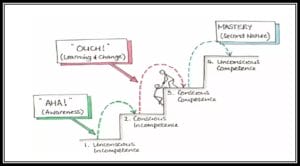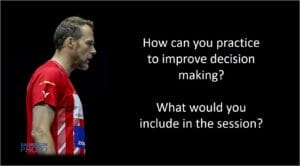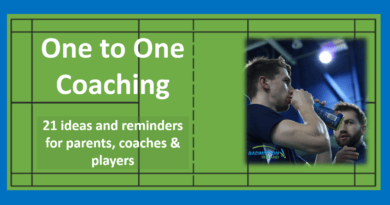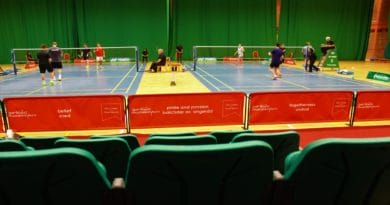My top 5 coaching mistakes
I wonder if you’ve made the same mistakes as I have
Most of them could have been avoided if only someone had told me about them
I’m not sure if any of them ever came up in my Coach Education courses
I wish they had! 🙂
– – – – – – – – – – – – – – – – – –
Do you recognise any of these?
1. Talking to players and coaches in the same way
2. Not watching players in competition
3. Thinking that technical practice translates into tactical play
4. Viewing practices from my perspective (as a player)
5. That Practice Performance translates into Competition Performance
– – – – – – – – – – – – – – – –
1. Talking to players and coaches in the same way
I’d never thought about this or the consequences
I believed that the more technical information players knew the better they would perform. I wished that I’d realised that having a player ‘know information’ wasn’t the key to their success.
It was what information they need that counted as there is certainly information that players need but it depends on their stage of development, the situation/context and if the specific need exists.
I found myself explaining every technical point, every reason ‘why’, all with the aim of imparting information. Often I sounded like a ‘coaching manual rather than a ‘playing manual’.
One is information that unpins how and what helps players develop/learn (coaching manual) and the other is information that helps to players to perform in competition (playing manual)
It surprised me that there is information players need at one time but need to ‘forget’ in later development
Talking with Coaches
 This is a different situation, and YES in this context it is important to explain the ‘why, when, how’ underpinning themes when talking coach to coach.
This is a different situation, and YES in this context it is important to explain the ‘why, when, how’ underpinning themes when talking coach to coach.
Without coaches talking ‘coaching’ and sharing experiences/questions it will be very tough for any form of effective coach development.
My coaching mistake was not realising who I was talking to and adapting what I said. If you want to read more click on this image
Communications between Coach to Coach are certainly different than between Coach to Player
– – – – – – – – – – – – – – – –
2. Not watching players in competition
 This was another lesson I wished I’d learned much earlier
This was another lesson I wished I’d learned much earlier
It would have saved me from much heartache and soul searching. I thought that I knew how my players performed as I watched them in training every week.
However, when I watched them in competition at times I was shocked!
During practice, improvements were visible and progressive. So why in the competition did they either not perform to the same level or did the skill just disappear?
Why couldn’t I see all those Practice Improvements that were visible in Practice!!!
I’ve proposed 5 reasons why I think coaches don’t watch their players in a competition. Do any apply to you?
Click here to read
– – – – – – – – – – – – – – – –
3. Thinking that technical practice translates into tactical play
I probably knew this wasn’t true but didn’t want to believe it 🙁
Maybe it was because I didn’t understand how to coach tactics and certainly not how to introduce tactical thoughts to young players.
I coached in the ‘hope’ that all the technical elements would somehow combine together into tactical thoughts. Or maybe I just didn’t think that players could understand tactics until they were technical competent – I wish someone had told me how wrong I was.
Do you think it’s easier to coach players from a technical viewpoint?
What are the fundamental elements for tactical thoughts?
I assumed that if a player would ‘master’ all the elements of a technique (movement, hitting, accuracy, power, speed) then all they had to do was join them together in a rally.
Of course, they did perform technically well in a game (because they had practised the strokes), however, the choices they made with these techniques were the crucial variables. I could see that at times they made some strange decisions, or was that no decision at all, ‘they just hit shuttles!’
Just being able to perform a technique did not mean that they could put them together in a way that tested or outwitted their opponents.
They also struggle at crucial times (pressure points) to ensure their technique worked. I didn’t realise that part of tactical skills was the ability to control themselves and to recognise how the game/score could challenge them in different ways from the technical practices they had been practising.
When will someone create a set of underpinning Badminton Tactical basics
The thoughts that help players create tactical plans/ideas
 If you want to read more about decision making then click on this image
If you want to read more about decision making then click on this image
– – – – – – – – – – – – – – – –
4. Viewing practices from my perspective (as a player)
You may not see this as a coaching mistake
Maybe it’s okay to have a viewpoint on all your practice as if you were a player taking part in them. At least you’d be able to explore and reflect on the outcomes you’d experience if you were on the court.
I failed to realise that not everyone thought the way I did and that it was wrong to judge all practices from my viewpoint.
Be careful judging all practices using these questions …
“Did the practice work for me when I was a player?”
“Would I have enjoyed this practice?”
“Would I have been motivated to think that way?”
Can you separate your feelings (as a player) about practice now that you are a coach?
– – – – – – – – – – – – – – – –
5. That Practice Performance translates into Competition Performace
Be careful judging the performance level of your players based on what you see in practice. Maybe without knowing it, you are manipulating practices so that ‘Performance Improvements’ appear!
Your group will probably become good at the things you practice and many even start to ‘play’ in similar ways, using similar tactics and strokes. It’s not surprising that they favour the strokes you often practice.
You will see improvements in practice, however, is it certain to translate into a competition? This depends on how you structure your practice and how your players react to competition stresses.
I didn’t realise that competition was the best test of development and that what I observed in practice may only be a product of that practice. The challenge presented to me was how to introduce elements of competition (stress, environments, decisions) into practice.
When I did try to do this, I was often tempted to stop as the practice performance dipped or I felt that I’d lost control over the practice. Development and progress seemed to decrease sometimes, players got frustrated at the perceived lack of progress.
Some players even suggested that we should practice rather than play competitive games in practice !!
Try these ideas
- Work hard to ensure you practice aspects that apply to competition, not just practice to become better at practice.
- Play competitive games (including conditioned games). Ensure players are ‘tested’
- Bring in ‘Sparring Players’ (very important)
- Ask other coaches to comment on the practice matches and the type of practices you use




